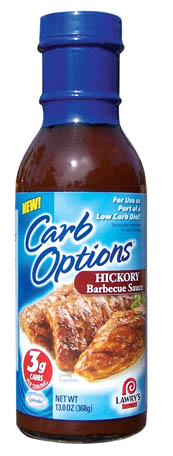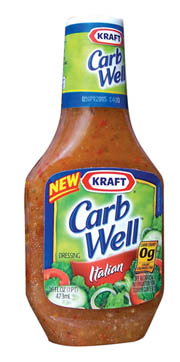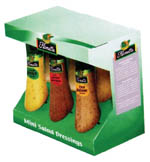
Convenient, healthful and tasty are three words that can be used to describe today's offering of bagged salads. They also are three words that can be used to explain the reason for the phenomenal growth of the category; bagged salad greens grew 13% between 2002 and 2004, according to Mintel International's Global New Products Database (GNPD, Chicago). On a related note, sales of salad dressings also have increased, although at a more moderate 3% in the same 2002-2004 period.
Salads and salad dressings continue to show signs of strong potential for ongoing success. Manufacturers have introduced a variety of products and packaging this year in efforts to establish themselves firmly in a growing, profitable category. New products introduced in 2004 can be grouped into four categories: health, packaging for convenience or freshness, premium quality/flavor and organic.

Suck It In
With the ongoing publicity concerning the obesity epidemic in the U.S., consumers often look for ways to increase the healthfulness of their diets.Salads have an inherent aura of healthfulness, which appeals to those who generally eat healthfully as well as to those who have a temporary need/desire to eat that way. Many salad companies have introduced new varieties of lettuce, not only for variety, but also to increase the “greenness,” and thus the healthfulness, of the salad. According to Mintel's report “Salads & Salad Dressings,” some dieticians consider iceberg lettuce significantly less nutritionally dense than other lettuce varieties. The dietary “rule of thumb” commonly put forward by nutritionists is “the darker the lettuce, the healthier it is.” Iceberg lettuce has significantly less vitamin A, vitamin C and folate than other leafy greens. While iceberg lettuce has some nutritional value, the focus is on darker greens, which explains the greater range of lettuces included in the newest bagged salads. While bagged salad producers still sell iceberg lettuce, it usually is blended with a number of darker greens such as romaine or escarole. For example, Fresh Express Farms (Salinas, Calif.) added two “Lettuce Trios” to their line in March 2004--one with green leaf lettuce, romaine and iceberg; the other with 100% romaine, cabbage and carrots.
On the salad dressing front, however, healthfulness is not assumed. For the most part, salad dressings contain high levels of fat, since they usually are made with oil. They serve a useful purpose, best explained by the Association for Dressings and Sauces (Atlanta): “A spoonful of dressing helps the nutrients go down…Salad dressing has been used for centuries to make nutrient-rich, low-fat, high-fiber foods taste better. When used properly and in the right amounts, salad dressing makes these typically bland foods more appealing.”
To address consumer needs to keep salads lower in calories or fat, many dressings offer a light, reduced-fat, low-fat and/or fat-free version. In addition, with low-carb dieters potentially looking to salad as a vehicle for their protein (eggs, turkey, ham, bacon, cheese), the need for complementary low-carb dressings has increased. Several manufacturers have introduced (or repositioned) “carbohydrate-conscious” versions in the last year. In May 2004, Kraft Foods North America (Northfield, Ill.) introduced Carb Well salad dressings--available in Roka Blue Cheese, Classic Caesar, Italian and Ranch. Kraft also extended its Carb Well dressing range to offer Carb Well Light Buttermilk Ranch, Creamy French and Light Italian dressings. Also in May 2004, Litehouse (Sandpoint, Idaho) unveiled One Carb Plus Dressings in Bleu Cheese, Ranch, Southwestern Ranch, Italian, Mediterranean Vinaigrette and Caesar varieties. In addition, T. Marzetti (Columbus, Ohio) added Creamy Caesar to the Marzetti 1 Carb Dressings line initially introduced in January 2004, while Unilever Foods (Greenwich, Conn.) extended its Carb Options line of dressings to offer Wishbone Low-carb Olive Oil Vinaigrette, Blue Cheese, and Low-carb Sweet and Spicy French Style dressing.
Convenient Packaging Sells Salads
Not only is the healthful salad itself important to consumers, packaging that keeps the product fresh and easy to consume also is crucial. One brand, Bistro To Go, from Ready Pac Produce (Irwindale, Calif.), appears to have successfully repositioned its salad offerings as portable, single-serve products. These salad bowls allow both fresh lettuce products and protein ingredients such as chicken, ham, cheese and boiled eggs to be packaged together. The tray is compartmentalized, to separate each of the salad ingredients, and consumers mix the Bistro to Go ingredients just before eating the salad. Ready Pac also has launched large, resealable, plastic salad bowls that offer family-sized portions of restaurant-style salad blends. Ready Pac promotes the ability to serve these salad products straight out of the bowl, making them a convenient option for parties and potlucks.To keep its salad products fresher longer, Dole Food (Westlake Village, Calif.) introduced new plastic container packaging for its Spring Mix salad, Baby Romaine and Baby Spinach products. The containers are reusable, if so desired. Likewise, Natural Selection Foods (San Juan Bautista, Calif.) introduced clamshell packaging for its salad and spinach products under the Earthbound Farm brand, which has been extremely successful. Consumers have responded well to this new packaging--not only because it keeps products much fresher, but also because it makes the salads more visible and results in less damage to them.
Freshness also is being achieved with packaging innovations such as the shrink-wrap packaging now offered with Tanimura & Antle's (Salinas, Calif.) new lettuce varieties. The company claims this type of packaging helps to decrease shrinkage and extends shelflife.

Bon Appetit
Consumers have an increasingly sophisticated palate, with many looking to replicate the unique tastes experienced in restaurants. From a taste perspective, the bagged salad industry has become much more adventuresome and flavorful. Iceberg lettuce now has many exciting complements in the salad bowl--Romaine, curly endive, frisée, radicchio, mizuna and arugula lettuces, among numerous others.In looking for restaurant-quality salads for at-home consumption, consumers can find premium salad blends developed by the famous TV chef, Emeril. Partnering with Pride of San Juan (San Juan Bautista, Calif.)--a farm that has supplied the baby lettuces for his show for several years, at his request--Emeril has launched his own line of salad blends with unique flavors and features comparable to restaurant salads. This includes spring mix, sweet salad mix (bitter greens removed) and several other special blends--for example, a plastic tub that has salad mix plus edible flower petals.
Dressings also have been introduced in bolder, creative and more ethnic flavors. New flavors are emerging such as Vidalia onion, peppercorn, raspberry hibiscus and Beaujolais. For example, Vita Specialty Foods (Chicago) introduced a Vidalia Onion Vinaigrette Salad Dressing, while Unilever Bestfoods (Englewood Cliffs, N.J.) added Raspberry Hazelnut Vinaigrette Dressing to its Wish-Bone Restaurant Style line.
Fresh Express offers an Oriental Salad Kit, “which includes everything you need to create a restaurant-style Oriental salad with crunchy veggies and a tangy dressing.”
Three new varieties of Hidden Valley Ranch by HV Food Products (Oakland, Calif.) have been introduced in 2004, including White Cheddar, Spicy Ranch and Old-Fashioned Buttermilk. They are promoted on the website not only as great salad dressings, but also as “limitless taste options” to create recipes normally seen in restaurants, such as Gazpacho Crab Salad and Buttermilk Fettuccine with Chicken Breasts.
T. Marzetti introduced a new item, promoted on its website as “Restaurant Quality”--Tuscan Italian, which contains only 1g of carbohydrates per serving.
Back to Nature
According to Mintel's “Organic Foods” report, sales of organic fruits and vegetables have increased 106% between 2001 and 2004, a constant 2004 sales increase of 94%. The rise is attributed, in part, to the increased availability of convenience organic products in mainstream channels. This increase has been driven by the success of organic Earthbound Farm branded products and by the expansion of Dole's and Fresh Express' organic salad products. Organic salads also have increased in popularity, as the price point between organic salads and conventional salads decreases. Some consumers also believe the product quality is better than non-organic, bagged salads.Earthbound Farms Organic Coastal Salad Blend is described as “a combination of chopped romaine, radicchio and baby lettuces made for chefs and consumers alike who have to buy two different bagged versions to get this variety.”
Innovative dressing flavors also are available in an organic format. Spectrum Organic Products' (Petaluma, Calif.) Organic Salad Dressing is now available in three new flavors: Provençal Garlic Lover's, Greek Goddess and Rocky Mountain Ranch. Organic Dressings for Kids are available from Annie's Naturals (North Calais, Vt.). The kid-friendly, healthful and all-natural flavors include Tutti Fruitti, Organic Pizza Pie and Organic Zoom.
Much of the information in this article was derived from Mintel International's Global New Products Database, www.gnpd.com, 312-932-0400.
Sidebar: Going Global
Variety and creativity is seen in salad dressing flavors across the globe. Cerebos Foods (Seven Hills, Australia) introduced a 98% fat-free Thai Beef Salad Dressing with lime and coriander components. Soleco's (France) introduced a pack of six mini salad dressings under the Florette brand that includes Fresh French Dressing and Fresh Balsamic Dressing. In Spain, McCormick & Co.'s Ducros brand (Sabadell, Spain) has introduced the iQue Ensalada! line of seasoning pastes, which need to be added to oil and vinegar to create an exotically flavored vinaigrette. The line of pastes packaged in round pots includes: Provencale style (Provenzal); garlic & parsley (Ajo y Perejil); and Basil & Oregano (Albahaca y Oregano). Unilever Bestfoods (Leioa, Spain) introduced Aliño Provenzal Salad Dressing, a bottle of salad dressing made from Provence herbs, sherry vinegar and extra virgin olive oil.On the green salad front, many new varieties of greens are appearing. Natura Nuova (Bagnacavallo, Italy) introduced Fantasia Salad Leaves, a green salad blend consisting of valeriana, riccia and scarola lettuces; carrots; red raddish and Milano raddish. In the U.K., Somerfield has introduced Jardin Salad, a mixed green salad with a French dressing. It contains Cos Lettuce (a sweet-tasting leaf with a firm yet succulent texture); Green Bativia (a mid- to light-green, frilly leaf with a slightly bitter flavor); and Mizuna (a light-green, serrated leaf with a white stem and mild mustard flavor).
Packaging innovation also is being seen on the international front. One creative product, first reported in Prepared Foods' April 2004 issue, is Bonduelle's (Peschiera Borromeo, Italy) new prepared salad under the name Agita e Gusta (“shake and taste”). The salad is packaged in a plastic tray with an inner tub holding a liquid dressing. By pressing on the tray, the seal on the tube is broken, releasing the dressing into the salad. The pack also comes with a napkin and plastic fork and has a board sleeve carrying product information. Varieties include a mixed leaf salad with sweet corn and black olives. Les Crudettes' (Chateauneuf-Sur-Loire,France) Salade Brasserie is based on a similar concept. The ready-made salad contains ham, sliced hard-boiled egg, cherry tomatoes, green salad and Emmental cheese. The product has two compartments. The salad is at the bottom, and the protein-rich components are in a separate compartment at the top. A disposable fork is included in the pack. Carrefour (Evry Cedex, France) also launched a similar package with its Salade Bistrot Snack Salad.
PHOTOS COURTESY OF MINTEL INTERNATIONAL'S GNPD
Links
- Les Crudettes' website (now you know why you should have learned more French in high school)
- In the LINX search field on the home page type “safe, satisfying” for an article on formulating dressings; type “salad” to look up a variety of articles on salads and salad dressings
- Association for Dressings and Sauces
- Mintel International's Global New Products Database